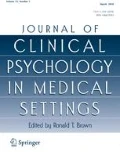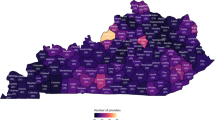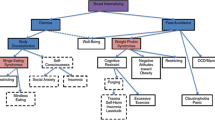Abstract
Eating disorders are associated with deleterious health consequences, increased risk of mortality, and psychosocial impairment. Although individuals with eating disorders are likely to seek treatment in general medical settings such as primary care (PC), these conditions are often under-detected by PC providers. However, psychologists in integrated PC settings are likely to see patients with eating disorders because of the mental health comorbidities associated with these conditions. Further, due to their training in identifying risk factors associated with eating disorders (i.e., comorbid mental health and medical disorders) and opportunities for collaboration with PC providers, psychologists are well-positioned to improve the detection and management of eating disorders in PC. This paper provides a brief overview of eating disorders and practical guidance for psychologists working in integrated PC settings to facilitate the identification and management of these conditions.

Similar content being viewed by others
References
Academy for Eating Disorders [AED] (2016). Eating Disorders: A Guide to Medical Care (3rd ed.). Reston, VA: Academy for Eating Disorders.
Allison, K. C., Lundgren, J. D., O’Reardon, J. P., Geliebter, A., Gluck, M. E., Vinai, P., ... Stunkard, A. J. (2010). Proposed diagnostic criteria for night eating syndrome. International Journal of Eating Disorders, 43, 241–247. doi:10.1002/eat.20693.
American Psychiatric Association [APA]. (2000). Diagnostic and Statistical Manual of Mental Disorders: Fourth Edition, Text Revision (DSM-IV-TR). Washington D.C.: American Psychiatric Association.
American Psychiatric Association [APA]. (2010). Practice Guideline for the Treatment of Patients with Eating Disorders (3rd ed.). Washington, D.C.: American Psychiatric Publishing.
American Psychiatric Association [APA]. (2013). Diagnostic and Statistical Manual of Mental Disorders (5th ed.). Washington, D.C.: American Psychiatric Publishing.
Arcelus, J., Mitchell, A. J., Wales, J., & Nielsen, S. (2011). Mortality rates in patients with Anorexia Nervosa and other eating disorders. Archives of General Psychiatry, 68, 724–731. doi:10.1001/archgenpsychiatry.2011.74.
Barnes, R. D., Masheb, R. M., White, M. A., & Grilo, C. M. (2011). Comparison of methods for identifying and assessing obese patients with binge eating disorder in primary care settings. International Journal of Eating Disorders, 44, 157–163. doi:10.1002/eat.20802.
Berg, K. C., Peterson, C. B., & Frazier, P. (2012a). Assessment and diagnosis of eating disorders: A guide for professional counselors. Journal of Counseling & Development, 90, 262–269. doi:10.1002/j.1556-6676.2012.00033.x.
Berg, K. C., Stiles-Shields, E. C., Swanson, S. A., Peterson, C. B., Lebow, J., & LeGrange, D. (2012b). Diagnostic concordance of the interview and questionnaire versions of the Eating Disorder Examination. International Journal of Eating Disorders, 45, 850–855. doi:10.1002/eat.20948.
Bundock, L., Howard, L. M., Trevillion, K., Malcolm, E., Feder, G., & Oram, S. (2013). Prevalence and risk of experiences of intimate partner violence among people with eating disorders: A systematic review. Journal of Psychiatric Research, 47, 1134–1142. doi:10.1016/j.jpsychires.2013.04.014.
Celio, A. A., Wilfley, D. E., Crow, S. J., Mitchell, J., & Walsh, B. T. (2004). A comparison of the binge eating scale, questionnaire for eating and weight patterns-revised, and eating disorder examination questionnaire with instructions with the eating disorder examination in the assessment of binge eating disorder and its symptoms. International Journal of Eating Disorders, 36, 434–444. doi:10.1002/eat.20057.
Centers for Disease Control and Prevention [CDC]. (2015). About BMI for adults. Retrieved from http://www.cdc.gov/healthyweight/assessing/bmi/adult_bmi/index.html. Accessed 13 Sept 2016.
Dansky, B. S., Brewerton, T. D., Kilpatrick, D. G., & O’Neil, P. M. (1997). The National Women’s Study: Relationship of victimization and posttraumatic stress disorder to bulimia nervosa. International Journal of Eating Disorders, 21, 213–228. doi:10.1002/(SICI)1098-108X(199704)21:3<213::AID-EAT2>3.0.CO;2-N.
Elran-Barak, R., Fitzsimmons-Craft, E. E., Benyamini, Y., Crow, S. J., Peterson, C. B., Hill, L. L., ... & Le Grange, D. (2015). Anorexia nervosa, bulimia nervosa, and binge eating disorder in midlife and beyond. The Journal of Nervous and Mental Disease, 203, 583–590. doi:10.1097/nmd0000000000000333.
Fairburn, C. G. (2008). Cognitive Behavioral Therapy and Eating Disorders. New York: Guilford Press, Inc.
Fairburn, C. G. (2013). Overcoming binge eating: Second edition: The proven program to learn why you binge and how you can stop. New York: Guilford Press, Inc.
Fairburn, C. G., Bailey-Straebler, S., Basden, S., Doll, H. A., Jones, R., Murphy, R., O’Connor, M. E., & Cooper, Z. (2015). A transdiagnostic comparison of enhanced cognitive behavior therapy (CBT-E) and interpersonal psychotherapy in the treatment of eating disorders. Behavior Research and Therapy, 70, 64–71. doi:10.1016/j.brat.2015.04.010.
Fairburn, C. G., & Beglin, S. J. (1994). Assessment of eating disorders: Interview or self-report questionnaire? International Journal of Eating Disorders, 16, 363–370. doi:10.1002/1098-108X(199412)16:4<363::AID-EAT2260160405>3.0.CO;2#.
Fairburn, C. G., & Beglin, S. J. (2008). Eating disorder examination questionnaire. In C. G. Fairburn (Ed.), Cognitive Behavioral Therapy and Eating Disorders. New York: Guilford Press, pp. 309–313.
Fairburn, C. G., & Cooper, Z. (1993). The eating disorder examination (12th ed.). In C. G. Fairburn & G. T. Wilson (Eds.), Binge eating: Nature, assessment and treatment. New York: Guilford Press.
Fairburn, C. G., Cooper, Z., & Shafran, R. (2003). Cognitive behavior therapy for eating disorders: A “transdiagnostic” theory and treatment. Behavior Research and Therapy, 41, 509–528. doi:10.1016/s0005-7967(02)00088-8.
Fairburn, C. G., & Harrison, P. J. (2003). Eating disorders. The Lancet, 361, 407–416. doi:10.1016/s0140-6736(03)12378-1.
Flament, M. F., Buchholz, A., Henderson, K., Obeid, N., Maras, D., Schubert, N., ... & Goldfield, G. (2015). Comparative distribution and validity of DSM-IV and DSM-5 diagnoses of eating disorders in adolescents from the community. European Eating Disorders Review, 23, 100–110. doi:10.1002/erv.2339.
Franko, D. L., Dorer, D. J., Keel, P. K., Jackson, S., Manzo, M. P., & Herzog, D. B. (2005). How do eating disorders and alcohol use disorder influence each other? International Journal of Eating Disorders, 38, 200–207. doi:10.1002/eat.20178.
Gadalla, T., & Piran, N. (2007). Co-occurrence of eating disorders and alcohol use disorders in women: A meta analysis. Archives of Women’s Mental Health, 10, 133–140. doi:10.1007/s00737-007-0184-x.
Garner, D. M. (2002). Body image and anorexia nervosa. In T. F. Cash & T. Pruzinsky (Eds.), Body image: A handbook of theory, research, and clinical practice (pp. 295–303). New York: The Guilford Press.
Gatchel, R. J., & Oordt, M. S. (2003). Clinical health psychology and primary care: Practical advice and clinical guidance for successful collaboration. Washington, D.C.: American Psychological Association.
Gideon, N., Hawkes, N., Mond, J., Saunders, R., Tchanturia, K., & Serpell, L. (2016). Development and psychometric validation of the EDE-QS, a 12 item short form of the eating disorder examination questionnaire (EDE-Q). PLoS ONE, 11(5), e0152744. doi:10.1371/journal.pone.0152744.
Godart, N., Radon, L., Curt, F., Duclos, J., Perdereau, F., Lang, F., ... & Flament, M.F. (2015). Mood disorders in eating disorder patients: Prevalence and chronology of onset. Journal of Affective Disorders, 185, 115–122. doi:10.1016/j.jad.2015.06.039.
Harrington, B. C., Jimerson, M., Haxton, C., & Jimerson, D. C. (2015). Initial evaluation, diagnosis, and treatment of anorexia nervosa and bulimia nervosa. American Family Physician, 91(1), 46–52. Retrieved from http://www.aafp.org/afp/2015/0101/p46.html.
Harrop, E. N., & Marlatt, G. A. (2010). The comorbidity of substance use disorders and eating disorders in women: Prevalence, etiology, and treatment. Addictive Behaviors, 35, 392–398. doi:10.1016/j.addbeh.2009.12.016.
Hay, P. J., Marley, J., & Lemar, S. (1998). Covert eating disorders: The prevalence, characteristics and help-seeking of those with bulimic eating disorders in general practice. Primary Care Psychiatry, 4(2), 95–99.
Hill, L. S., Reid, F., Morgan, J. F., & Hubert, J. H. (2010). SCOFF: The development of an eating disorder screening questionnaire. International Journal of Eating Disorders, 43, 344–351. doi:10.1002/eat.20679.
Hinney, A., & Volckmar, A. L. (2013). Genetics of eating disorders. Current Psychiatry Reports, 15: 423. doi:10.1007/s11920-013-0423-y.
Hudson, J. I., Hiripi, E., Pope, H. G. Jr., & Kessler, R. C. (2007). The prevalence and correlates of eating disorders in the National Comorbidity Survey Replication. Biological Psychiatry, 61, 348–358. doi:10.1016/j.biopsych.2006.03.040.
Hunter, C. L., Goodie, J. L., Oordt, M. S., & Dobmeyer, A. C. (2009). Integrated behavioral health in primary care: Step-by-step guidance for assessment and intervention. Washington, D.C.: American Psychological Association.
Jacobi, C., Hayward, C., de Zwaan, M., Kraemer, H. C., & Agras, W. S. (2004). Coming to terms with risk factors for eating disorders: Application of risk terminology and suggestions for a general taxonomy. Psychological Bulletin, 130, 19–65. doi:10.1037/0033-2909.130.1.19.
Johnson, J. G., Spitzer, R. L., & Williams, J. B. (2001). Health problems, impairment and illnesses associated with bulimia nervosa and binge eating disorder among primary care and obstetric gynaecology patients. Psychological Medicine, 31, 1455–1466. doi:10.1017/s0033291701004640.
Kaslow, N. J., Kapoor, S., Dunn, S. E., & Graves, C. C. (2015). Psychologists’ contributions to patient-centered medical homes. Journal of Clinical Psychology in Medical Settings, 22, 199–212. doi:10.1007/s10880-015-9445-4.
Kaye, W. H., Bulik, C. M., Thornton, L., Barbarich, N., Masters, K., & Price Foundation Collaborative Group (2004). Comorbidity of anxiety disorders with anorexia and bulimia nervosa. American Journal of Psychiatry, 161, 2215–2221. doi:10.1176/appi.ajp.161.12.2215.
Keel, P. K., Dorer, D. J., Eddy, K. T., Franko, D., Charatan, D. L., & Herzog, D. B. (2003). Predictors of mortality in eating disorders. Archives of General Psychiatry, 60, 179–183. doi:10.1001/archpsyc.60.2.179.
Keel, P. K., & Striegel-Moore, R. H. (2009). The validity and clinical utility of purging disorder. International Journal of Eating Disorders, 42, 706–719. doi:10.1022/eat.20718.
Kelly, N. R., Mitchell, K. S., Gow, R. W., Trace, S. E., Lydecker, J. A., Bair, C. E., & Mazzeo, S. (2012). An evaluation of the reliability and construct validity of eating disorder measures in white and black women. Psychological Assessment, 24, 608–617. doi:10.1037/a0026457.
Killen, J. D., Taylor, C. B., Hayward, C., Haydel, K. F., Wilson, D. M., Hammer, L., ... & Strachowski, D. (1996). Weight concerns influence the development of eating disorders: A 4-year prospective study. Journal of Consulting and Clinical Psychology, 64, 936–940. doi:10.1037/0022-006X.64.5.936.
Knowles, L., Anohkina, S., & Serpell, L. (2013). Motivational interventions in the eating disorders: What is the evidence? International Journal of Eating Disorders, 46, 97–107. doi:10.1002/eat.22053.
Krabbenborg, M. A. M., Danner, U. N., Larsen, J. K., van der Veer, N., van Elburg, A. A., de Ridder, D. T. D., ... & Engels, R. C. M. E. (2012). The eating disorder diagnostic scale: Psychometric features within a clinical population and a cut-off point to differentiate clinical patients from healthy controls. European Eating Disorders Review, 20, 315–320. doi:10.1002/erv.1144.
Latner, J. D., & Wilson, G. T. (2007). Self-help approaches for obesity and eating disorders: Research and practice. New York: Guilford Press, Inc.
Luck, A.J., Morgan, J.F., Reid, F., O’Brien, A., Brunton, J., Price, C., ... & Lacey, J.H. (2002). The SCOFF questionnaire and clinical interview for eating disorders in general practice: Comparative study. British Medical Journal, 325, 755–756. Retrieved from http://www.bmj.com/thebmj.
Macdonald, P., Hibbs, R., Corfield, F., & Treasure, J. (2012). The use of motivational interviewing in eating disorders: A systematic review. Psychiatry Research, 200, 1–11. doi:10.1016/j.psychres.2012.05.013.
McDaniel, S. H., Grus, C. L., Cubic, B. A., Hunter, C. L., Kearney, L. K., Schuman, C. C., ... & Johnson, S. B. (2014). Competencies for psychology practice in primary care. American Psychologist, 69, 409–429. doi:10.1037/a0036072.
Mehler, P. S., & Brown, C. (2015). Anorexia Nervosa: Medical complications. Journal of Eating Disorders, 3(11). doi:10.1186/s40337-015-0040-8.
Mehler, P. S., & Rylander, M. (2015). Bulimia Nervosa: Medical complications. Journal of Eating Disorders, 3(12). doi:10.1186/s40337-015-0044-4.
Mitchell, J. E. (2016). Medical comorbidity and medical complications associated with binge-eating disorder. International Journal of Eating Disorders, 49, 319–323. doi:10.1002/eat.22452.
Mitchell, J. E., Myers, T., Crosby, R., O’Neill, G., Carlisle, J., & Gerlach, S. (2009). Health care utilization in patients with eating disorders. International Journal of Eating Disorders, 42, 571–574. doi:10.1002/eat.20651.
Mitchell, J. E., & Peterson, C. B. (2005). Assessment of Eating Disorders. New York: Guilford Press.
Mitchell, K. S., Mazzeo, S. E., Schlesinger, M. R., Brewerton, T. D., & Smith, B. N. (2012). Comorbidity of partial and subthreshold PTSD among men and women with eating disorders in the National Comorbidity Survey-Replication Study. International Journal of Eating Disorders, 45, 307–315. doi:10.1002/eat.20965.
Mond, J. M., Hay, P. J., Rodgers, B., & Owen, C. (2007). Health service utilization for eating disorders: Findings from a community-based study. International Journal of Eating Disorders, 40, 399–408. doi:10.1002/eat.20382.
Mond, J. M., Hay, P. J., Rodgers, B., Owen, C., & Beumont, P. J. V. (2004). Validity of the Eating Disorder Examination Questionnaire (EDE-Q) in screening for eating disorders in community samples. Behaviour Research and Therapy, 42, 551–567. doi:10.1016/S0005-7967(03)00161-X.
Mond, J. M., Myers, T. C., Crosby, R., Hay, P., Mitchell, J. (2008a). ‘Excessive exercise’ and eating-disordered behavior in young adult women: Further evidence from a primary care sample. European Eating Disorders Review, 16, 215–221. doi:10.1002/erv.855.
Mond, J. M., Myers, T. C., Crosby, R. D., Hay, P. J., Rodgers, B., Morgan, J. F., ... & Mitchell, J. E. (2008b). Screening for eating disorders in primary care: EDE-Q versus SCOFF. Behavior, Research, and Therapy, 46, 612–622. doi:10.1016/j.brat.2008.02.003.
Morgan, J. F., Reid, F., & Lacey, J. H. (1999). The SCOFF questionnaire: Assessment of a new screening tool for eating disorders. British Medical Journal, 319, 1467. doi:10.1136/bmj.319.7223.1467.
National Eating Disorders Association [NEDA]. (2016). Get screened: 3 Minutes Can Save a Life. Retrieved from: http://nedawareness.org/get-screened.
Neumark-Sztainer, D., & Eisenberg, M. E. (2014). Body image concerns, muscle-enhancing behaviors, and eating disorders in males. Journal of the American Medical Association, 312, 2156–2157. doi:10.1001/jama.2014.5138.
Pallister, E., & Waller, G. (2008). Anxiety in the eating disorders: Understanding the overlap. Clinical Psychology Review, 28, 366–386. doi:10.1016/j.cpr.2007.07.001.
Peterson, C. B. (2005). Conducting the diagnostic interview. In J. E. Mitchell & C. B. Peterson (Eds.), Assessment of Eating Disorders (pp. 32–58). New York: The Guilford Press.
Roehrig, J. P., & McLean, C. P. (2010). A comparison of stigma toward eating disorders versus depression. International Journal of Eating Disorders, 43, 671–674. doi:10.1002/eat.20760.
Sim, L. A., McAlpine, D. E., Grothe, K. B., Himes, S. M., Cockerill, R. G., & Clark, M. M. (2010). Identification and treatment of eating disorders in the primary care setting. Mayo Clinic Proceedings, 85, 746–751. doi:10.4065/mcp.2010.0070.
Smolak, L., & Murnen, S. K. (2002). A meta-analytic examination of the relationship between child sexual abuse and eating disorders. International Journal of Eating Disorders, 31, 136–150. doi:10.1002/eat.10008.
Spitzer, R. L., Yanovski, S. Z., & Marcus, M.D. (1994). Questionnaire on Eating and Weight Patterns, Revised. Pittsburgh PA: Behavioral Measurement Database Services (Producer).
Stice, E. (2001). A prospective test of the dual-pathway model of bulimic pathology: Mediating effects of dieting and negative affect. Journal of Abnormal Psychology, 110, 124–135. doi:10.1037//0021-843X.110.1.124.
Stice, E. (2002). Risk and maintenance factors for eating pathology: A meta-analytic review. Psychological Bulletin, 128, 825–848. doi:10.1037//0033-2909.128.5.825.
Stice, E., & Agras, W. S. (1998). Predicting onset and cessation of bulimic behaviors during adolescence: A longitudinal grouping analysis. Behavior therapy, 29, 257–276. doi:10.1016/S0005-7894(98)80006-3.
Stice, E., Davis, K., Miller, N. P., & Marti, C. N. (2008). Fasting increases risk for onset of binge eating and bulimic pathology: A 5-year prospective study. Journal of Abnormal Psychology, 117, 941–946. doi:10.1037/a0013644.
Stice, E., Fisher, M., & Martinez, E. (2004). Eating disorder diagnostic scale: Additional evidence of reliability and validity. Psychological Assessment, 16, 60–71. doi:10.1037/1040-3590.16.1.60.
Stice, E., Telch, C. F., & Rizvi, S. L. (2000). Development and validation of the eating disorder diagnostic scale: A brief self-report measure of anorexia, bulimia, and binge-eating disorder. Psychological Assessment, 12, 123–131. doi:10.1037/1040-3590.12.2.123.
Striegel-Moore, R. H., DeBar, L., Wilson, G. T., Dickerson, J., Rosselli, F., Perrin, N., ... & Kraemer, H.C (2008). Health services use in eating disorders. Psychological Medicine, 38, 1465–1474. doi:10.1017/s0033291707001833.
Trace, S. E., Baker, J. H., Peñas-Lledó, E., & Bulik, C. M. (2013). The genetics of eating disorders. Annual Review of Clinical Psychology, 9, 589–620. doi:10.1146/annurev-clinpsy-050212-185546.
Traviss-Turner, G. D., West, R. M., & Hill, A. J. (2017). Guided self-help for eating disorders: A systematic review and metaregression. European Eating Disorders Review, 25, 148–164. doi:10.1002/erv.2507.
United States Bureau of Labor, Bureau of Labor Statistics. (2012). Division of Occupational Employment Statistics. Washington, D.C. Retrieved from http://www.bs.gov/oes.
Vitousek, K., Watson, S., & Wilson, G.T. (1998). Enhancing motivation for change in treatment-resistant eating disorders. Clinical Psychology Review, 18(4), 391–420. Retrieved from https://www.journals.elsevier.com/clinical-psychology-review/.
Walsh, B. T., & Satir, D. A. (2005). Diagnostic issues. In J. E. Mitchell & C. B. Peterson (Eds.), Assessment of Eating Disorders (pp. 1–16). New York: The Guilford Press.
Wilson, G. T., Grilo, C. M., & Vitousek, K. M. (2007). Psychological treatment of eating disorders. American Psychologist, 62, 199–216. doi:10.1037/0003-066X.62.3.199.
Wilson, G. T., Vitousek, K. M., & Loeb, K. L. (2000). Stepped care treatment for eating disorders. Journal of Consulting and Clinical Psychology, 68, 564–572. doi:10.1037/0022-006X.68.4.564.
World Health Organization [WHO]. (2010). BMI classification. http://apps.who.int/bmi/index.jsp?introPage=intro_3.htm. Accessed 13 Sept 2016.
Yager, J., Devlin, M. J., Halmi, K. A., Herzog, D. B., Mitchell, J. E., Powers, P., & Zerbe, K. J. (2010). Practice guideline for the treatment of patients with eating disorders (3rd ed.). Washington, D.C.: American Psychiatric Association.
Yanovski, S. Z. (1993). Binge eating disorder: Current knowledge and future directions. Obesity Research, 1, 306–324. doi:10.1002/j.1550-8528.1993.tb00626.x.
Yanovski, S. Z., Marcus, M. D., Wadden, T. A., & Walsh, B. T. (2015). The Questionnaire on Eating and Weight Patterns-5: An updated screening instrument for binge eating disorder. International Journal of Eating Disorders, 48, 259–261. doi:10.1002/eat.22372.
Acknowledgements
Manuscript preparation was supported by the VA Office of Academic Affiliations, Advanced Fellowship Program in Mental Illness Research and Treatment, the VA Center for Integrated Healthcare, and by use of facilities and resources at the VA Western New York Healthcare System.
Author information
Authors and Affiliations
Corresponding author
Ethics declarations
Conflict of interest
Laura J. Buchholz, Paul R. King, and Laura O. Wray declare that they have no conflicts of interest to report.
Human and Animal Rights and Informed Consent
This article does not contain any studies with human participants or animals performed by any of the authors.
Additional information
The views expressed in this article are those of the authors and do not necessarily represent the position or policy of the Department of Veterans Affairs or the United States Government.
Rights and permissions
About this article
Cite this article
Buchholz, L.J., King, P.R. & Wray, L.O. Identification and Management of Eating Disorders in Integrated Primary Care: Recommendations for Psychologists in Integrated Care Settings. J Clin Psychol Med Settings 24, 163–177 (2017). https://doi.org/10.1007/s10880-017-9497-8
Published:
Issue Date:
DOI: https://doi.org/10.1007/s10880-017-9497-8




